Site Selection of Urban Parks Based on Fuzzy-Analytic Hierarchy Process (F-AHP): A Case Study of Nanjing, China
Abstract
:1. Introduction
2. Materials and Methods
2.1. Study Area and Data Sources
2.2. Determination of Urban Park Site Selection Criteria and Spatial Data Acquisition
2.2.1. Urban Park Site Selection Criteria
2.2.2. Geospatial Data Acquisition
2.3. Classification of Standards
2.4. Weighting of Criteria
2.5. Sensitivity Analysis
3. Results
3.1. Weights Obtained by F-AHP Method
3.2. Nanjing City Park Site Selection Area
3.3. Results of Sensitivity Analysis
4. Discussion
4.1. Discussion of Research Methods
4.2. Limitations and Future Research Directions
5. Conclusions
Author Contributions
Funding
Informed Consent Statement
Data Availability Statement
Conflicts of Interest
References
- Wu, J.G.; Xiang, W.N.; Zhao, J.Z. Urban ecology in China: Historical developments and future directions. Landsc. Urban Plann. 2014, 125, 222–233. [Google Scholar] [CrossRef]
- Zhang, M.; Du, H.Q.; Zhou, G.M.; Mao, F.J.; Li, X.J.; Zhou, L.; Zhu, D.E.; Xu, Y.X.; Huang, Z.H. Spatiotemporal Patterns and Driving Force of Urbanization and Its Impact on Urban Ecology. Remote Sens. 2022, 14, 1160. [Google Scholar] [CrossRef]
- Zhao, Y.; Zhang, Y.C.; Destech Publicat, I. Study on Ecological Environmental Problems and Their Countermeasures in the Process of Rural Urbanization. In Proceedings of the 2016 International Conference on Environmental Science and Engineering (ESE 2016), Guilin, China, 15–17 April 2016; pp. 822–827. [Google Scholar]
- Peng, J.; Pan, Y.J.; Liu, Y.X.; Zhao, H.J.; Wang, Y.L. Linking ecological degradation risk to identify ecological security patterns in a rapidly urbanizing landscape. Habitat Int. 2018, 71, 110–124. [Google Scholar] [CrossRef]
- Li, Y.C.; Xiong, W.T.; Wang, X.P. Does polycentric and compact development alleviate urban traffic congestion? A case study of 98 Chinese cities. Cities 2019, 88, 100–111. [Google Scholar] [CrossRef]
- Lu, J.; Li, B.; Li, H.; Al-Barakani, A. Expansion of city scale, traffic modes, traffic congestion, and air pollution. Cities 2021, 108, 102974. [Google Scholar] [CrossRef]
- Zhao, P.J.; Hu, H.Y. Geographical patterns of traffic congestion in growing megacities: Big data analytics from Beijing. Cities 2019, 92, 164–174. [Google Scholar] [CrossRef]
- Ojuederie, O.B.; Babalola, O.O. Microbial and Plant-Assisted Bioremediation of Heavy Metal Polluted Environments: A Review. Int. J. Environ. Res. Public Health 2017, 14, 1504. [Google Scholar] [CrossRef] [Green Version]
- Zhang, W.; Villarini, G.; Vecchi, G.A.; Smith, J.A. Urbanization exacerbated the rainfall and flooding caused by hurricane Harvey in Houston. Nature 2018, 563, 384–388. [Google Scholar] [CrossRef]
- Huang, Z.H.; Du, X.J. Urban Land Expansion and Air Pollution: Evidence from China. J. Urban Plann. Dev. 2018, 144, 05018017. [Google Scholar] [CrossRef]
- Kanniah, K.D. Quantifying green cover change for sustainable urban planning: A case of Kuala Lumpur, Malaysia. Urban For. Urban Green. 2017, 27, 287–304. [Google Scholar] [CrossRef]
- Syrakoy, A.C. Urban environmental degradation: Realities and historical illusions. Eur. J. Environ. Sci. 2018, 8, 38–43. [Google Scholar] [CrossRef]
- Wang, Z.J. Cause Analysis and Treatment Measures of Urban Traffic Congestion. In Proceedings of the 2016 International Conference on Advances in Management, Arts and Humanities Science (AMAHS 2016), Taichung, Taiwan, 10–11 December 2016; pp. 36–39. [Google Scholar]
- Valavanidis, A.; Vlachogianni, T.; Fiotakis, K.; Loridas, S. Pulmonary Oxidative Stress, Inflammation and Cancer: Respirable Particulate Matter, Fibrous Dusts and Ozone as Major Causes of Lung Carcinogenesis through Reactive Oxygen Species Mechanisms. Int. J. Environ. Res. Public Health 2013, 10, 3886–3907. [Google Scholar] [CrossRef]
- Chen, X.Y.; Shao, S.A.; Tian, Z.H.; Xie, Z.; Yin, P. Impacts of air pollution and its spatial spillover effect on public health based on China’s big data sample. J. Cleaner Prod. 2017, 142, 915–925. [Google Scholar] [CrossRef]
- Kabisch, N.; Haase, D. Green spaces of European cities revisited for 1990–2006. Landsc. Urban Plann. 2013, 110, 113–122. [Google Scholar] [CrossRef]
- Pirmoradian, F.; Ashtari, I. Investigation of socio-economic and environmental functions of urban green space. Int. J. Ecosyst. Ecol. Sci. 2020, 10, 179–188. [Google Scholar] [CrossRef]
- Kothencz, G.; Kolcsar, R.; Cabrera-Barona, P.; Szilassi, P. Urban Green Space Perception and Its Contribution to Well-Being. Int. J. Environ. Res. Public Health 2017, 14, 766. [Google Scholar] [CrossRef] [Green Version]
- Zhang, Y.; van Dijk, T.; Tang, J.J.; van den Berg, A.E. Green Space Attachment and Health: A Comparative Study in Two Urban Neighborhoods. Int. J. Environ. Res. Public Health 2015, 12, 14342–14363. [Google Scholar] [CrossRef] [Green Version]
- Zhu, J.Y.; Xu, C.Y. Sina microblog sentiment in Beijing city parks as measure of demand for urban green space during the COVID-19. Urban For. Urban Green. 2021, 58, 126913. [Google Scholar] [CrossRef]
- Sung, H.; Kim, W.R.; Oh, J.; Lee, S.; Lee, P.S.H. Are All Urban Parks Robust to the COVID-19 Pandemic? Focusing on Type, Functionality, and Accessibility. Int. J. Environ. Res. Public Health 2022, 19, 6062. [Google Scholar] [CrossRef]
- Wang, F.; Lu, Y.; Li, J.; Ni, J. Evaluating Environmentally Sustainable Development Based on the PSR Framework and Variable Weigh Analytic Hierarchy Process. Int. J. Environ. Res. Public Health 2021, 18, 2836. [Google Scholar] [CrossRef]
- Uyan, M. GIS-based solar farms site selection using analytic hierarchy process (AHP) in Karapinar region, Konya/Turkey. Renew. Sustain. Energy Rev. 2013, 28, 11–17. [Google Scholar] [CrossRef]
- De Feo, G.; De Gisi, S. Using MCDA and GIS for hazardous waste landfill siting considering land scarcity for waste disposal. Waste Manag. 2014, 34, 2225–2238. [Google Scholar] [CrossRef] [PubMed]
- Yesilnacar, M.I.; Suzen, M.L.; Kaya, B.S.; Doyuran, V. Municipal solid waste landfill site selection for the city of Sanliurfa-Turkey: An example using MCDA integrated with GIS. Int. J. Digital Earth 2012, 5, 147–164. [Google Scholar] [CrossRef]
- Gigovic, L.J.; Pamucar, D.; Lukic, D.; Markovic, S. GIS-Fuzzy DEMATEL MCDA model for the evaluation of the sites for ecotourism development: A case study of "Dunayski kljuc" region, Serbia. Land Use Policy 2016, 58, 348–365. [Google Scholar] [CrossRef]
- Musakwa, W. Identifying land suitable for agricultural land reform using GIS-MCDA in South Africa. Environ. Dev. Sustain. 2018, 20, 2281–2299. [Google Scholar] [CrossRef]
- Sahani, N. Assessment of ecotourism potentiality in GHNPCA, Himachal Pradesh, India, using remote sensing, GIS and MCDA techniques. Asia-Pac. J. Reg. Sci. 2019, 3, 623–646. [Google Scholar] [CrossRef]
- Sardar, T.; Raziq, A.; Rashid, A.; Saddiq, G. Snow avalanche based susceptibility assessment of selected districts in northern zone of Pakistan applying MCDA approach in GIS. J. Himal. Earth Sci. 2019, 52, 64–73. [Google Scholar]
- Pakfetrat, A.; Taghvaei, M.; Zarrabi, A. A comprehensive approach in green space site planning: An application of a three-stage multi-criteria decision support system. Urban Res. Pract. 2020, 13, 45–76. [Google Scholar] [CrossRef]
- Neema, M.N.; Ohgai, A. Multi-objective location modeling of urban parks and open spaces: Continuous optimization. Comput. Environ. Urban Syst. 2010, 34, 359–376. [Google Scholar] [CrossRef]
- Olaniyi, O.E.; Akindele, S.O.; Ogunjemite, B.G. Ecotourism suitability of Okomu and Pendjari national parks. Anatolia 2018, 29, 593–604. [Google Scholar] [CrossRef]
- Ristić, V.; Maksin, M.; Nenković-Riznić, M.; Basarić, J. Land-use evaluation for sustainable construction in a protected area: A case of Sara mountain national park. J. Environ. Manag. 2018, 206, 430–445. [Google Scholar] [CrossRef] [PubMed]
- Georgiou, A.; Skarlatos, D. Optimal site selection for sitting a solar park using multi-criteria decision analysis and geographical information systems. Geosci. Instrum. Methods Data Syst. 2016, 5, 321–332. [Google Scholar] [CrossRef] [Green Version]
- Zhang, J.; Wei, W.; Cheng, Y.; Zhao, B. Study on site selection of small and medium-sized city parks based on GIS suitability evaluation. J. Nanjing For. Univ 2019, 43, 171–178. [Google Scholar]
- Bathrellos, G.D.; Skilodimou, H.D.; Chousianitis, K.; Youssef, A.M.; Pradhan, B. Suitability estimation for urban development using multi-hazard assessment map. Sci. Total Environ. 2017, 575, 119–134. [Google Scholar] [CrossRef] [PubMed]
- Wang, G.F.; Lyu, H.M.; Shen, J.S.L.; Lu, L.H.; Li, G.; Arulrajah, A. Evaluation of Environmental Risk Due to Metro System Construction in Jinan, China. Int. J. Environ. Res. Public Health 2017, 14, 1114. [Google Scholar] [CrossRef] [Green Version]
- Penacoba-Antona, L.; Gomez-Delgado, M.; Esteve-Nunez, A. Multi-Criteria Evaluation and Sensitivity Analysis for the Optimal Location of Constructed Wetlands (METland) at Oceanic and Mediterranean Areas. Int. J. Environ. Res. Public Health 2021, 18, 5415. [Google Scholar] [CrossRef] [PubMed]
- Yi, Y.; Zhang, C.; Zhu, J.Q.; Zhang, Y.G.; Sun, H.; Kang, H.Z. Spatio-Temporal Evolution, Prediction and Optimization of LUCC Based on CA-Markov and InVEST Models: A Case Study of Mentougou District, Beijing. Int. J. Environ. Res. Public Health 2022, 19, 2432. [Google Scholar] [CrossRef]
- Zabihi, H.; Alizadeh, M.; Wolf, I.D.; Karami, M.; Ahmad, A.; Salamian, H. A GIS-based fuzzy-analytic hierarchy process (F-AHP) for ecotourism suitability decision making: A case study of Babol in Iran. Tour. Manag. Perspect. 2020, 36, 100726. [Google Scholar] [CrossRef]
- Zhang, Y.; Shen, J.; Li, Y. Atmospheric Environment Vulnerability Cause Analysis for the Beijing-Tianjin-Hebei Metropolitan Region. Int. J. Environ. Res. Public Health 2018, 15, 128. [Google Scholar] [CrossRef] [Green Version]
- Nilashi, M.; Ahmadi, H.; Ahani, A.; Ravangard, R.; bin Ibrahim, O. Determining the importance of Hospital Information System adoption factors using Fuzzy Analytic Network Process (ANP). Technol. Forecast. Soc. Change 2016, 111, 244–264. [Google Scholar] [CrossRef]
- Zadeh, L.A. Fuzzy sets. Inf. Control. 1965, 8, 394–432. [Google Scholar] [CrossRef] [Green Version]
- Fadafan, F.K.; Danehkar, A.; Pourebrahim, S. Developing a non-compensatory approach to identify suitable zones for intensive tourism in an environmentally sensitive landscape. Ecol. Indic. 2018, 87, 152–166. [Google Scholar] [CrossRef]
- Ozturk, D.; Kilic-Gul, F. GIS-based multi-criteria decision analysis for parking site selection. Kuwait J. Sci. 2020, 47, 2–15. [Google Scholar]
- Gorsevski, P.V.; Donevska, K.R.; Mitrovski, C.D.; Frizado, J.P. Integrating multi-criteria evaluation techniques with geographic information systems for landfill site selection: A case study using ordered weighted average. Waste Manag. 2012, 32, 287–296. [Google Scholar] [CrossRef] [PubMed]
- Dashti, S.; Monavari, S.M.; Hosseini, S.M.; Riazi, B.; Momeni, M. Application of GIS, AHP, Fuzzy and WLC in Island Ecotourism Development (Case study of Qeshm Island, Iran). Life Sci. J. 2013, 10, 1274–1282. [Google Scholar]
- Ustaoglu, E.; Aydinoglu, A.C. Suitability evaluation of urban construction land in Pendik district of Istanbul, Turkey. Land Use Policy 2020, 99, 104783. [Google Scholar] [CrossRef]
- Vahidnia, M.H.; Alesheikh, A.A.; Alimohammadi, A. Hospital site selection using fuzzy AHP and its derivatives. J. Environ. Manag. 2009, 90, 3048–3056. [Google Scholar] [CrossRef]
- Singh, S.; Sharma, P.K.; Yoon, B.; Shojafar, M.; Cho, G.H.; Ra, I.H. Convergence of blockchain and artificial intelligence in IoT network for the sustainable smart city. Sustain. Cities Soc. 2020, 63, 102364. [Google Scholar] [CrossRef]
- Dominkovic, D.F.; Bacekovic, I.; Pedersen, A.S.; Krajacic, G. The future of transportation in sustainable energy systems: Opportunities and barriers in a clean energy transition. Renew. Sustain. Energy Rev. 2018, 82, 1823–1838. [Google Scholar] [CrossRef]
- Rahman, M.R.; Shi, Z.H.; Cai, C.F. Assessing regional environmental quality by integrated use of remote sensing, GIS, and spatial multi-criteria evaluation for prioritization of environmental restoration. Environ. Monit. Assess. 2014, 186, 6993–7009. [Google Scholar] [CrossRef]
- Burger, J. Environmental management: Integrating ecological evaluation, remediation, restoration, natural resource damage assessment and long-term stewardship on contaminated lands. Sci. Total Environ. 2008, 400, 6–19. [Google Scholar] [CrossRef] [PubMed] [Green Version]
- Malav, L.C.; Yadav, K.K.; Gupta, N.; Kumar, S.; Sharma, G.K.; Krishnan, S.; Rezania, S.; Kamyab, H.; Pham, Q.B.; Yadav, S.; et al. A review on municipal solid waste as a renewable source for waste-to-energy project in India: Current practices, challenges, and future opportunities. J. Cleaner Prod. 2020, 277, 123227. [Google Scholar] [CrossRef]
- Kumar, A.; Samadder, S.R. A review on technological options of waste to energy for effective management of municipal solid waste. Waste Manag. 2017, 69, 407–422. [Google Scholar] [CrossRef] [PubMed]
- Ouda, O.K.M.; Raza, S.A.; Nizami, A.S.; Rehan, M.; Al-Waked, R.; Korres, N.E. Waste to energy potential: A case study of Saudi Arabia. Renew. Sustain. Energy Rev. 2016, 61, 328–340. [Google Scholar] [CrossRef]
- Xiao, Y.; Wang, Z.; Li, Z.G.; Tang, Z.L. An assessment of urban park access in Shanghai-Implications for the social equity in urban China. Landscape Urban Plann. 2017, 157, 383–393. [Google Scholar] [CrossRef]
- Kronenberg, J.; Haase, A.; Laszkiewicz, E.; Antal, A.; Baravikova, A.; Biernacka, M.; Dushkova, D.; Filcak, R.; Haase, D.; Ignatieva, M.; et al. Environmental justice in the context of urban green space availability, accessibility, and attractiveness in postsocialist cities. Cities 2020, 106, 102862. [Google Scholar] [CrossRef]
- Velenturf, A.P.M.; Purnell, P. Principles for a sustainable circular economy. Sustain. Prod. Consum. 2021, 27, 1437–1457. [Google Scholar] [CrossRef]
- Wang, X.Y.; Wang, Q. Research on the impact of green finance on the upgrading of China’s regional industrial structure from the perspective of sustainable development. Resour. Policy 2021, 74, 102436. [Google Scholar] [CrossRef]
- Meyfroidt, P.; de Bremond, A.; Ryan, C.M.; Archer, E.; Aspinall, R.; Chhabra, A.; Camara, G.; Corbera, E.; DeFries, R.; Diaz, S.; et al. Ten facts about land systems for sustainability. Proc. Natl. Acad. Sci. USA 2022, 119, e2109217118. [Google Scholar] [CrossRef]
- Liang, X.; Guan, Q.F.; Clarke, K.C.; Liu, S.S.; Wang, B.Y.; Yao, Y. Understanding the drivers of sustainable land expansion using a patch-generating land use simulation (PLUS) model: A case study in Wuhan, China. Comput. Environ. Urban Syst. 2021, 85, 101569. [Google Scholar] [CrossRef]
- Sharifi, A.; Khavarian-Garmsir, A.R. The COVID-19 pandemic: Impacts on cities and major lessons for urban planning, design, and management. Sci. Total Environ. 2020, 749, 142391. [Google Scholar] [CrossRef] [PubMed]
- He, B.J.; Zhao, D.X.; Xiong, K.; Qi, J.D.; Ulpiani, G.; Pignatta, G.; Prasad, D.; Jones, P. A framework for addressing urban heat challenges and associated adaptive behavior by the public and the issue of willingness to pay for heat resilient infrastructure in Chongqing, China. Sustain. Cities Soc. 2021, 75, 103361. [Google Scholar] [CrossRef]
- Yigitcanlar, T.; Dizdaroglu, D. Ecological approaches in planning for sustainable cities: A review of the literature. Glob. J. Environ. Sci. Manag. 2015, 1, 159–188. [Google Scholar]
- Burton, E.; Jenks, M.; Williams, K. Achieving Sustainable Urban Form, 1st ed.; Katie Williams, E.B.A., Jenks, M., Eds.; Routledge: New York, NY, USA, 2013; pp. 337–347. [Google Scholar]
- Jabareen, Y.R. Sustainable urban forms: Their typologies, models, and concepts. J. Plan. Educ. Res. 2006, 26, 38–52. [Google Scholar] [CrossRef]
- Cheng, Y.; Zhao, M. On the GaWC world city list and its application in China. Urban Plan. Forum 2018, 6, 54–60. [Google Scholar]
- Chen, J.L.; Gao, J.L.; Yuan, F.; Wei, Y.D. Spatial Determinants of Urban Land Expansion in Globalizing Nanjing, China. Sustainability 2016, 8, 868. [Google Scholar] [CrossRef]
- Yu, Z.W.; Yang, G.Y.; Zuo, S.D.; Jorgensen, G.; Koga, M.; Vejre, H. Critical review on the cooling effect of urban blue-green space: A threshold-size perspective. Urban For. Urban Green. 2020, 49, 126630. [Google Scholar] [CrossRef]
- White, M.P.; Pahl, S.; Ashbullby, K.; Herbert, S.; Depledge, M.H. Feelings of restoration from recent nature visits. J. Environ. Psychol. 2013, 35, 40–51. [Google Scholar] [CrossRef]
- Powers, S.L.; Pitas, N.A.; Barrett, A.G.; Graefe, A.R.; Mowen, A.J. Local Policy-Makers’ Community Priorities and Perceived Contributions of Parks and Recreation. J. Park Recreat. Adm. 2021, 39, 37–54. [Google Scholar] [CrossRef]
- Jennings, V.; Bamkole, O. The Relationship between Social Cohesion and Urban Green Space: An Avenue for Health Promotion. Int. J. Environ. Res. Public Health 2019, 16, 452. [Google Scholar] [CrossRef] [Green Version]
- Kong, F.H.; Yin, H.W.; James, P.; Hutyra, L.R.; He, H.S. Effects of spatial pattern of greenspace on urban cooling in a large metropolitan area of eastern China. Landscape Urban Plann. 2014, 128, 35–47. [Google Scholar] [CrossRef]
- Cao, X.; Onishi, A.; Chen, J.; Imura, H. Quantifying the cool island intensity of urban parks using ASTER and IKONOS data. Landscape Urban Plann. 2010, 96, 224–231. [Google Scholar] [CrossRef]
- Gunawardena, K.R.; Wells, M.J.; Kershaw, T. Utilising green and bluespace to mitigate urban heat island intensity. Sci. Total Environ. 2017, 584, 1040–1055. [Google Scholar] [CrossRef]
- Aronson, M.F.J.; Lepczyk, C.A.; Evans, K.L.; Goddard, M.A.; Lerman, S.B.; MacIvor, J.S.; Nilon, C.H.; Vargo, T. Biodiversity in the city: Key challenges for urban green space management. Front. Ecol. Environ. 2017, 15, 189–196. [Google Scholar] [CrossRef] [Green Version]
- Demuzere, M.; Orru, K.; Heidrich, O.; Olazabal, E.; Geneletti, D.; Orru, H.; Bhave, A.G.; Mittal, N.; Feliu, E.; Faehnle, M. Mitigating and adapting to climate change: Multi-functional and multi-scale assessment of green urban infrastructure. J. Environ. Manag. 2014, 146, 107–115. [Google Scholar] [CrossRef] [PubMed]
- Gascon, M.; Triguero-Mas, M.; Martinez, D.; Dadvand, P.; Forns, J.; Plasencia, A.; Nieuwenhuijsen, M.J. Mental Health Benefits of Long-Term Exposure to Residential Green and Blue Spaces: A Systematic Review. Int. J. Environ. Res. Public Health 2015, 12, 4354–4379. [Google Scholar] [CrossRef] [PubMed]
- Fritz, M. Nature-Based Solutions to Climate Change Adaptation in Urban Areas-Linkages between Science, Policy and Practice; Derk Loorbach, H.S., Julia, M., Junichi Fujino, S.M., Eds.; Springer: Cham, Switzerland, 2017; pp. 1–11. [Google Scholar] [CrossRef]
- Nesshover, C.; Assmuth, T.; Irvine, K.N.; Rusch, G.M.; Waylen, K.A.; Delbaere, B.; Haase, D.; Jones-Walters, L.; Keune, H.; Kovacs, E.; et al. The science, policy and practice of nature-based solutions: An interdisciplinary perspective. Sci. Total Environ. 2017, 579, 1215–1227. [Google Scholar] [CrossRef]
- Ustaoglu, E.; Aydinoglu, A.C. Land Suitability Assessment of Green Infrastructure Development A Case Study of Pendik District (Turkey). Tema-J. Land Use Mobil. Environ. 2019, 12, 165–178. [Google Scholar] [CrossRef]
- Zhou, Y.; Shi, T.-M.; Hu, Y.-M.; Gao, C.; Liu, M.; Song, L.-Q. Location selection for Shenyang urban parks based on GIS and multi-objective location allocation model. Ying Yong Sheng Tai Xue Bao 2011, 22, 3307–3314. [Google Scholar]
- Yuan, Z.; Tiemao, S.; Chang, G. Multi-objective optimal location planning of urban parks. In Proceedings of the 2011 International Conference on Electronics, Communications and Control (ICECC), Ningbo, China, 9–11 September 2011; pp. 918–921. [Google Scholar]
- Zhang, X.R.; Fang, C.L.; Wang, Z.B.; Ma, H.T. Urban Construction Land Suitability Evaluation Based on Improved Multi-criteria Evaluation Based on GIS (MCE-GIS): Case of New Hefei City, China. Chin. Geogr. Sci. 2013, 23, 740–753. [Google Scholar] [CrossRef] [Green Version]
- Luan, C.; Liu, R.; Peng, S. Land-use suitability assessment for urban development using a GIS-based soft computing approach: A case study of Ili Valley, China. Ecol. Indic. 2021, 123, 7333. [Google Scholar] [CrossRef]
- Feizizadeh, B.; Roodposhti, M.S.; Jankowski, P.; Blaschke, T. A GIS-based extended fuzzy multi-criteria evaluation for landslide susceptibility mapping. Comput. Geosci. 2014, 73, 208–221. [Google Scholar] [CrossRef] [Green Version]
- Bathrellos, G.D.; Kalivas, D.P.; Skilodimou, H.D. GIS-based landslide susceptibility mapping models applied to natural and urban planning in Trikala, Central Greece. Estud. Geol.-Madr. 2009, 65, 49–65. [Google Scholar] [CrossRef] [Green Version]
- Akinci, H.; Ozalp, A.Y.; Turgut, B. Agricultural land use suitability analysis using GIS and AHP technique. Comput. Electron. Agric. 2013, 97, 71–82. [Google Scholar] [CrossRef]
- Bennie, J.; Huntley, B.; Wiltshire, A.; Hill, M.O.; Baxter, R. Slope, aspect and climate: Spatially explicit and implicit models of topographic microclimate in chalk grassland. Ecol. Model. 2008, 216, 47–59. [Google Scholar] [CrossRef]
- Chun, B.; Hur, M.; Won, J. Impacts of Thermal Environments on Health Risk: A Case Study of Harris County, Texas. Int. J. Environ. Res. Public Health 2021, 18, 5531. [Google Scholar] [CrossRef]
- Cantini, F.; Castelli, G.; Foderi, C.; Garcia, A.S.; de Armentia, T.L.; Bresci, E.; Salbitano, F. Evidence-Based Integrated Analysis of Environmental Hazards in Southern Bolivia. Int. J. Environ. Res. Public Health 2019, 16, 2107. [Google Scholar] [CrossRef] [Green Version]
- Yang, Z.; Jiang, P.; Zhang, H.Y.; Cheng, P. Study on Urban Heat Island Intensity Level Identification Based on an Improved Restricted Boltzmann Machine. Int. J. Environ. Res. Public Health 2018, 15, 186. [Google Scholar] [CrossRef] [Green Version]
- Qiao, W.Y.; Guan, W.H.; Huang, X.J. Assessing the Potential Impact of Land Use on Carbon Storage Driven by Economic Growth: A Case Study in Yangtze River Delta Urban Agglomeration. Int. J. Environ. Res. Public Health 2021, 18, 1924. [Google Scholar] [CrossRef]
- Hansen, W.G. How accessibility shapes land-use. J. Am. Inst. Plann. 1959, 25, 73–76. [Google Scholar] [CrossRef]
- Hancock, P.A.; Hutchinson, M.F. Spatial interpolation of large climate data sets using bivariate thin plate smoothing splines. Environ. Model. Softw. 2006, 21, 1684–1694. [Google Scholar] [CrossRef]
- Jimenez-Munoz, J.C.; Sobrino, J.A.; Skokovic, D.; Mattar, C.; Cristobal, J. Land Surface Temperature Retrieval Methods From Landsat-8 Thermal Infrared Sensor Data. IEEE Geosci. Remote Sens. Lett. 2014, 11, 1840–1843. [Google Scholar] [CrossRef]
- McBratney, A.B.; Odeh, I.O.A. Application of fuzzy sets in soil science: Fuzzy logic, fuzzy measurements and fuzzy decisions. Geoderma 1997, 77, 85–113. [Google Scholar] [CrossRef]
- Xu, H.Y.; Vilanova, R. Application of Fuzzy Control on Wastewater Treatment Plant for P-removal. In Proceedings of the 2015 23rd Mediterranean Conference on Control and Automation (MED), Torremolinos, Spain, 16–19 June 2015; pp. 545–550. [Google Scholar]
- Malczewski, J. GIS and Multicriteria Decision Analysis; John Wiley & Sons: New York, NY, USA, 1999. [Google Scholar]
- Jiang, H.; Eastman, J.R. Application of fuzzy measures in multi-criteria evaluation in GIS. Int. J. Geog. Inf. Sci. 2000, 14, 173–184. [Google Scholar] [CrossRef]
- Islam, M.; Kashem, S.; Morshed, S. Integrating spatial information technologies and fuzzy analytic hierarchy process (F-AHP) approach for landfill siting. City Environ. Interact. 2020, 7, 100045. [Google Scholar] [CrossRef]
- Rahimi, S.; Ashournejad, Q.; Moore, A.B.; Ghorbani, H. Optimal siting of edutainment energy parks through the modelling of weighted spatial decision criteria. J. Cleaner Prod. 2020, 255, 120279. [Google Scholar] [CrossRef]
- Ronizi, S.R.A.; Mokarram, M.; Negahban, S. Utilizing multi-criteria decision to determine the best location for the ecotourism in the east and central of Fars province, Iran. Land Use Policy 2020, 99, 105095. [Google Scholar] [CrossRef]
- Pussel, P.; Li, L. Identification and assessment of the driving forces for the use of urban green parks and their accessibility in Colombo, Sri Lanka, through analytical hierarchical processing. Geospat. Health 2019, 14, 72–80. [Google Scholar] [CrossRef]
- Smith, J.P.; Meerow, S.; Turner, B.L. Planning urban community gardens strategically through multicriteria decision analysis. Urban For. Urban Green. 2021, 58, 126897. [Google Scholar] [CrossRef]
- Shadman, S.; Khalid, P.A.; Hanafiah, M.M.; Koyande, A.K.; Islam, M.A.; Bhuiyan, S.A.; Kok, S.W.; Show, P.L. The carbon sequestration potential of urban public parks of densely populated cities to improve environmental sustainability. Sustain. Energy Technol. Assess. 2022, 52, 102064. [Google Scholar] [CrossRef]
- Gratani, L.; Varone, L.; Bonito, A. Carbon sequestration of four urban parks in Rome. Urban For. Urban Green. 2016, 19, 184–193. [Google Scholar] [CrossRef]
- Wang, J.; Zhang, Y. Service quality evaluation of urban parks based on AHP method and SD software. J. Appl. Sci. 2014, 14, 291–295. [Google Scholar] [CrossRef] [Green Version]
- Özdağoğlu, A.; Özdağoğlu, G. Comparison of AHP and fuzzy AHP for the multi-criteria decision making processes with linguistic evaluations. İstanbul Ticaret Üniversitesi Fen Bilim. Derg. 2007, 6, 65–85. [Google Scholar]
- Chang, D.Y. Applications of the extent analysis method on fuzzy AHP. Eur. J. Oper. Res. 1996, 95, 649–655. [Google Scholar] [CrossRef]
- Sui, M.-G.; We, Y. Discussion and Improvement on Calculating Quotiety Using Fuzzy AHP. J. Shanxi Univ. Nat. Sci. Ed. 2000, 23, 218–220. [Google Scholar]
- Singh, R.K.; Gunasekaran, A.; Kumar, P. Third party logistics (3PL) selection for cold chain management: A fuzzy AHP and fuzzy TOPSIS approach. Ann. Oper. Res. 2018, 267, 531–553. [Google Scholar] [CrossRef]
- Selcuk, L. An avalanche hazard model for Bitlis Province, Turkey, using GIS based multicriteria decision analysis. Turk. J. Earth Sci. 2013, 22, 523–535. [Google Scholar] [CrossRef]
- Lee, S. Determination of Priority Weights under Multiattribute Decision-Making Situations: AHP versus Fuzzy AHP. J. Constr. Eng. Manag. 2015, 141, 05014015. [Google Scholar] [CrossRef]
- Coffey, L.; Claudio, D. In defense of group fuzzy AHP: A comparison of group fuzzy AHP and group AHP with confidence intervals. Expert Syst. Appl. 2021, 178, 114970. [Google Scholar] [CrossRef]
- Saaty, T.L. A scaling method for priorities in hierarchical structures. J. Math. Psychol. 1977, 15, 234–281. [Google Scholar] [CrossRef]
- Daniel, C. On varying one factor at a time. Biometrics 1958, 14, 430–431. [Google Scholar] [CrossRef]
- Saatsaz, M.; Monsef, I.; Rahmani, M.; Ghods, A. Site suitability evaluation of an old operating landfill using AHP and GIS techniques and integrated hydrogeological and geophysical surveys. Environ. Monit. Assess. 2018, 190, 144. [Google Scholar] [CrossRef] [PubMed]
- Chen, Y.; Yu, J.; Khan, S. Spatial sensitivity analysis of multi-criteria weights in GIS-based land suitability evaluation. Environ. Model. Softw. 2010, 25, 1582–1591. [Google Scholar] [CrossRef]
- Nyimbili, P.H.; Erden, T. A Hybrid Approach Integrating Entropy-AHP and GIS for Suitability Assessment of Urban Emergency Facilities. ISPRS Int. J. Geo-Inf. 2020, 9, 419. [Google Scholar] [CrossRef]
- Xu, E.Q.; Zhang, H.Q. Spatially-explicit sensitivity analysis for land suitability evaluation. Appl. Geogr. 2013, 45, 1–9. [Google Scholar] [CrossRef]
- Caner, H.I.; Aydin, C.C. Shipyard site selection by raster calculation method and AHP in GIS environment, Iskenderun, Turkey. Mar. Policy 2021, 127, 104439. [Google Scholar] [CrossRef]
- Juan, Y.K.; Hsu, Y.C.; Chang, Y.P. Site Selection Assessment of Vacant Campus Space Transforming into Daily Care Centers for The Aged. Int. J. Strateg. Prop. Manag. 2021, 25, 34–49. [Google Scholar] [CrossRef]
- Rahmat, Z.G.; Niri, M.V.; Alavi, N.; Goudarzi, G.; Babaei, A.A.; Baboli, Z.; Hosseinzadeh, M. Landfill site selection using GIS and AHP: A case study: Behbahan, Iran. KSCE J. Civ. Eng. 2017, 21, 111–118. [Google Scholar] [CrossRef]
- Sequeira, M.; Hilletofth, P.; Adlemo, A. AHP-based support tools for initial screening of manufacturing reshoring decisions. J. Glob. Oper. Strateg. Sourc. 2021, 14, 502–527. [Google Scholar] [CrossRef]
- Guo, J.Y.; Liu, J.; Qiu, L.; Society, I.C. Research on supply chain performance evaluation based on DEA/AHP model. In Proceedings of the APSCC: 2006 IEEE Asia-Pacific Conference on Services Computing, Guangzhou, China, 12–15 December 2006; pp. 609–612. [Google Scholar]
- Kritikos, T.; Davies, T.R.H. GIS-based Multi-Criteria Decision Analysis for landslide susceptibility mapping at northern Evia, Greece. Z. Der Dtsch. Ges. Für Geowiss. 2011, 162, 421–434. [Google Scholar] [CrossRef]
- Chen, V.Y.C.; Lien, H.P.; Liu, C.H.; Liou, J.J.H.; Tzeng, G.H.; Yang, L.S. Fuzzy MCDM approach for selecting the best environment-watershed plan. Appl. Soft Comput. 2011, 11, 265–275. [Google Scholar] [CrossRef]
- Janssen, J.; Krol, M.S.; Schielen, R.M.J.; Hoekstra, A.Y. The effect of modelling expert knowledge and uncertainty on multicriteria decision making: A river management case study. Environ. Sci. Policy 2010, 13, 229–238. [Google Scholar] [CrossRef]
- Kordi, M.; Brandt, S.A. Effects of increasing fuzziness on analytic hierarchy process for spatial multicriteria decision analysis. Comput. Environ. Urban Syst. 2012, 36, 43–53. [Google Scholar] [CrossRef] [Green Version]
- Mosadeghi, R.; Warnken, J.; Tomlinson, R.; Mirfenderesk, H. Uncertainty analysis in the application of multi-criteria decision-making methods in Australian strategic environmental decisions. J. Environ. Plann. Manag. 2013, 56, 1097–1124. [Google Scholar] [CrossRef] [Green Version]
- Zhang, K.J.; Achari, G. Uncertainty propagation in environmental decision making using random sets. In Proceedings of the International Conference on Ecological Informatics and Ecosystem Conservation (ISEIS 2010), Beijing, China, 27–29 August 2010; pp. 576–584. [Google Scholar]
- Li, F.; Phoon, K.K.; Du, X.; Zhang, M. Improved AHP method and its application in risk identification. J. Constr. Eng. Manag. 2013, 139, 312–320. [Google Scholar] [CrossRef] [Green Version]
- Sugihara, K.; Ishii, H.; Tanaka, H. Fuzzy AHP with incomplete information. In Proceedings of the Proceedings Joint 9th IFSA World Congress and 20th NAFIPS International Conference, (Cat. No. 01TH8569). Vancouver, BC, Canada, 25–28 July 2001; pp. 2730–2733. [Google Scholar]
- Lyu, H.-M.; Sun, W.-J.; Shen, S.-L.; Zhou, A.-N. Risk assessment using a new consulting process in fuzzy AHP. J. Constr. Eng. Manag. 2020, 146, 04019112. [Google Scholar] [CrossRef]
- Talukdar, S.; Naikoo, M.W.; Mallick, J.; Praveen, B.; Sharma, P.; Islam, A.R.M.T.; Pal, S.; Rahman, A. Coupling geographic information system integrated fuzzy logic-analytical hierarchy process with global and machine learning based sensitivity analysis for agricultural suitability mapping. Agric. Syst. 2022, 196, 103343. [Google Scholar] [CrossRef]
- Skilodimou, H.D.; Bathrellos, G.D.; Chousianitis, K.; Youssef, A.M.; Pradhan, B. Multi-hazard assessment modeling via multi-criteria analysis and GIS: A case study. Environ. Earth Sci. 2019, 78, 47. [Google Scholar] [CrossRef]
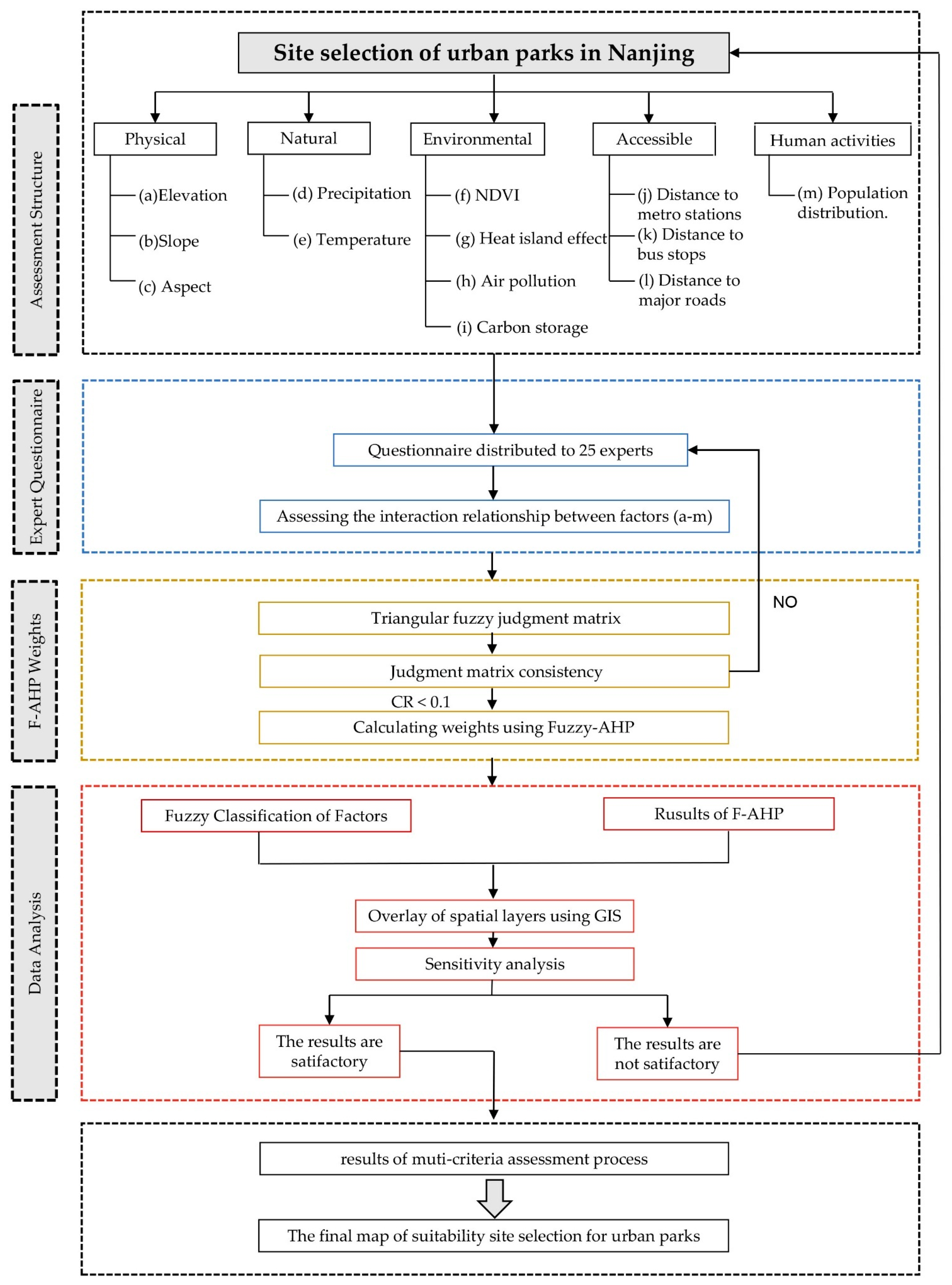
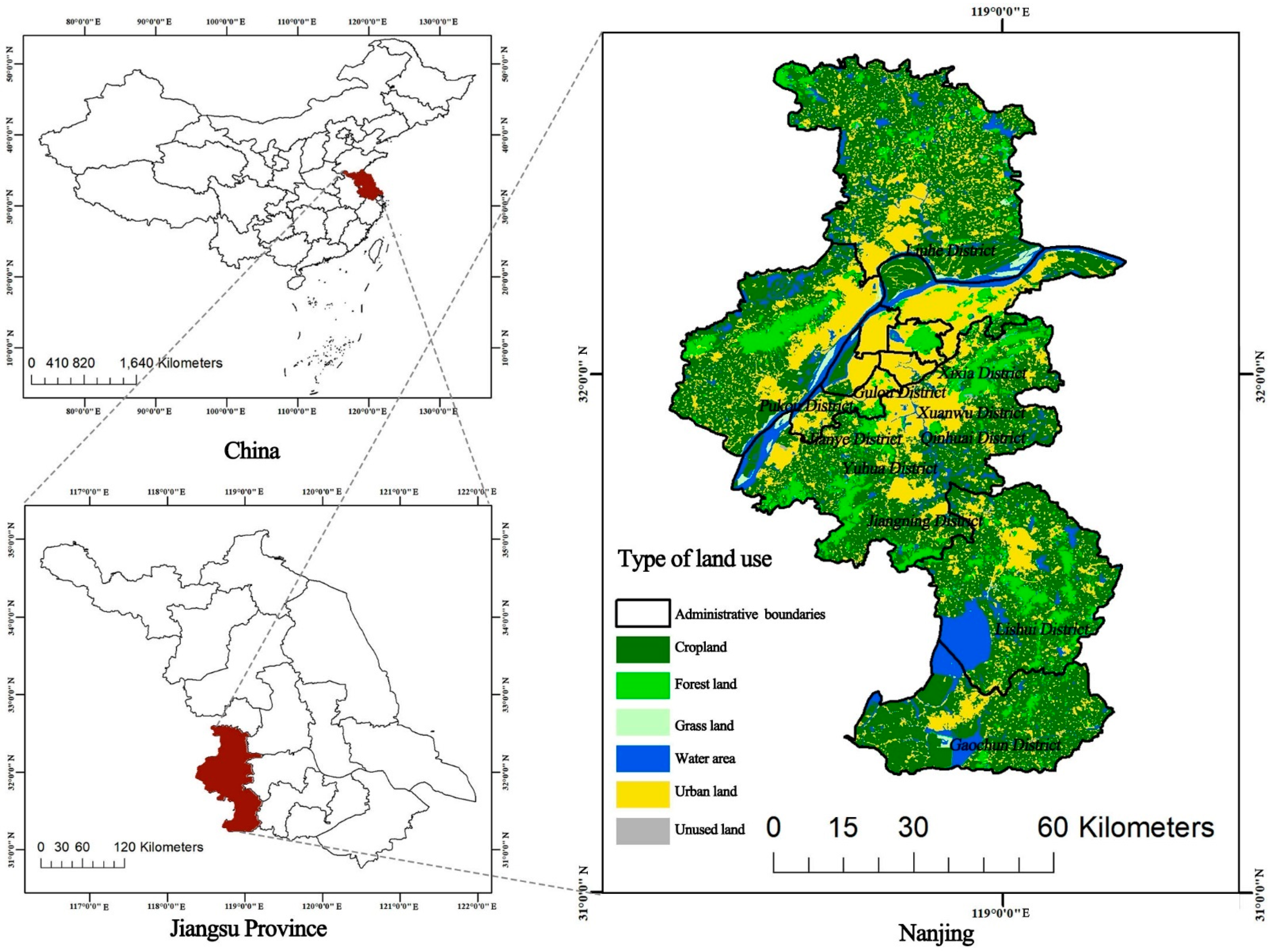
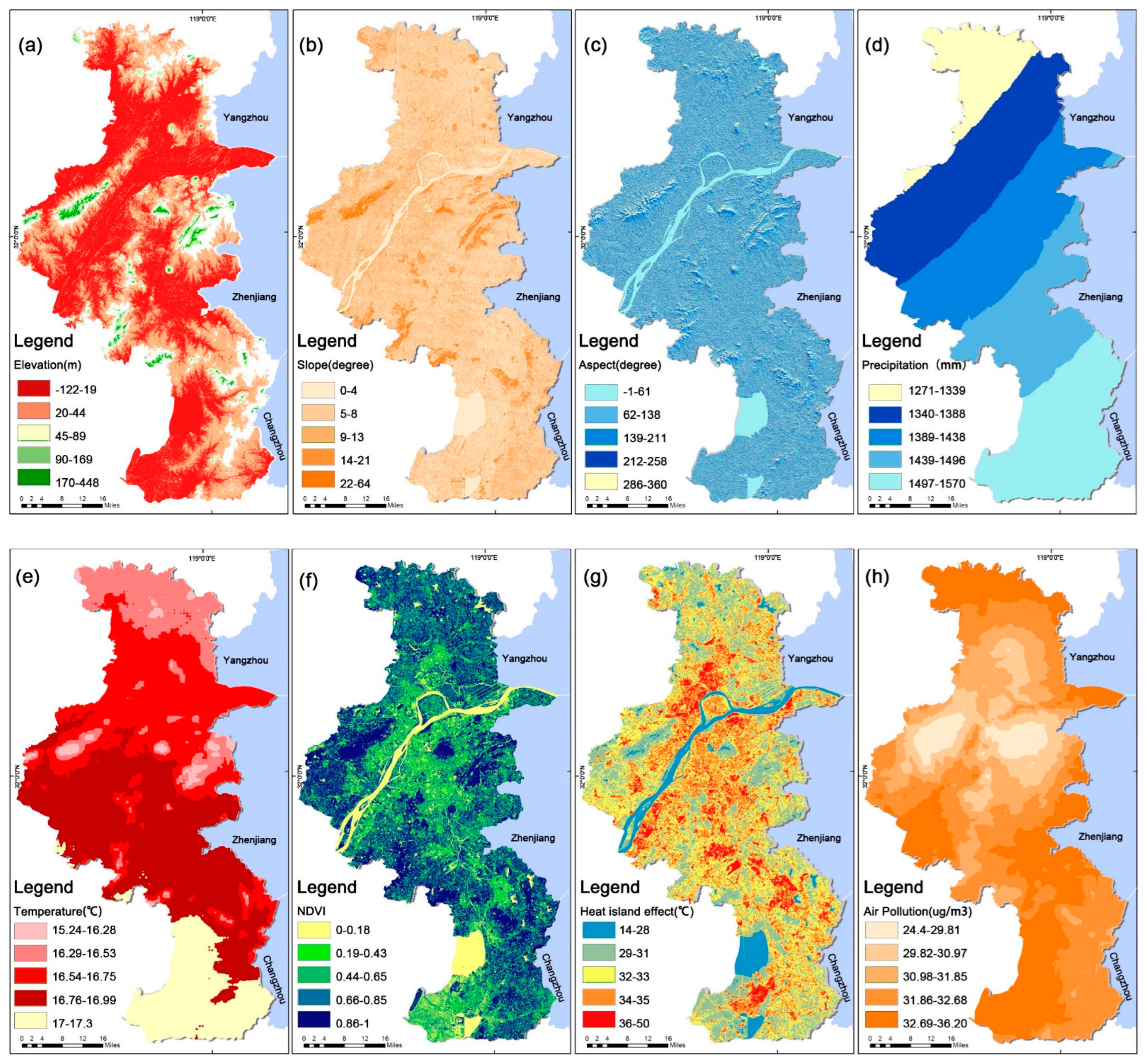

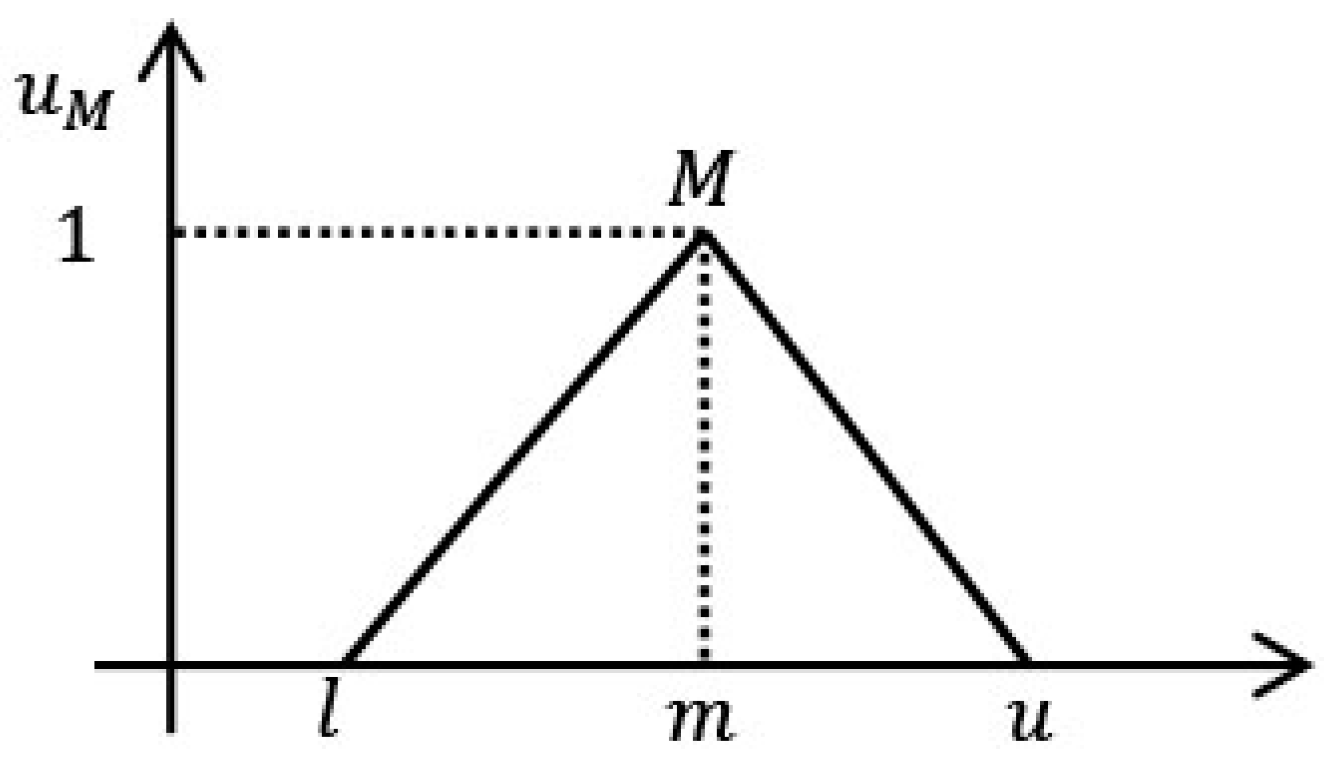
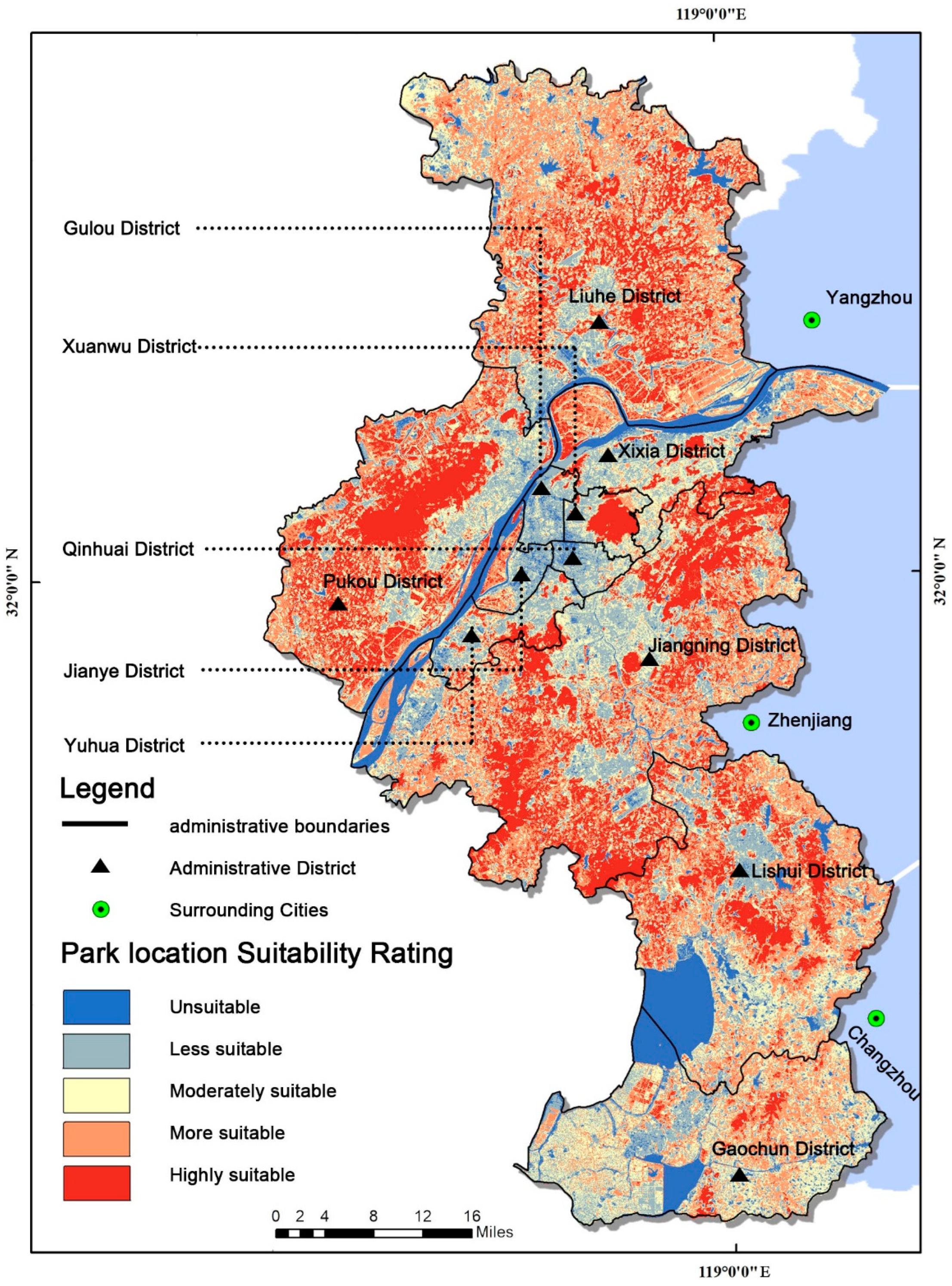
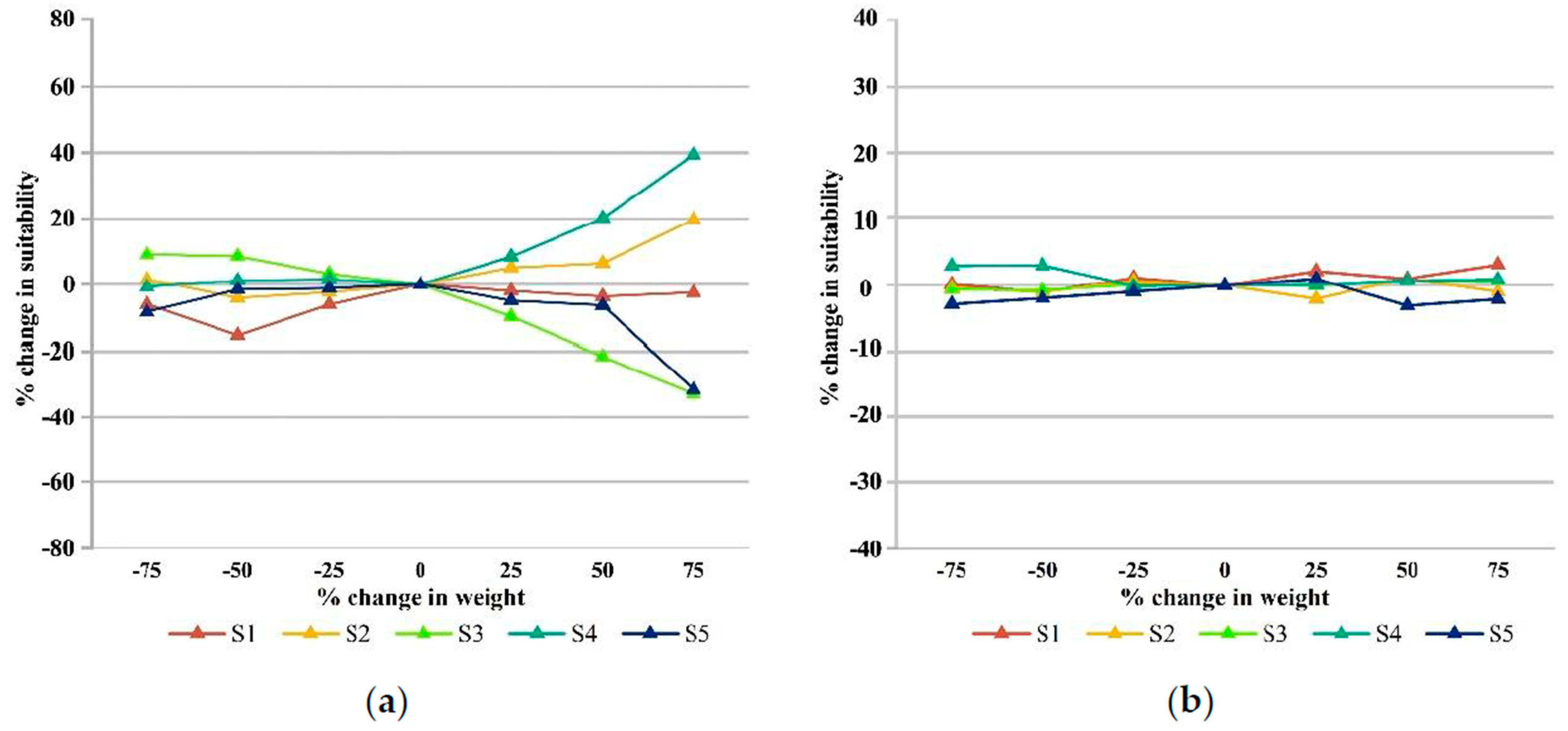
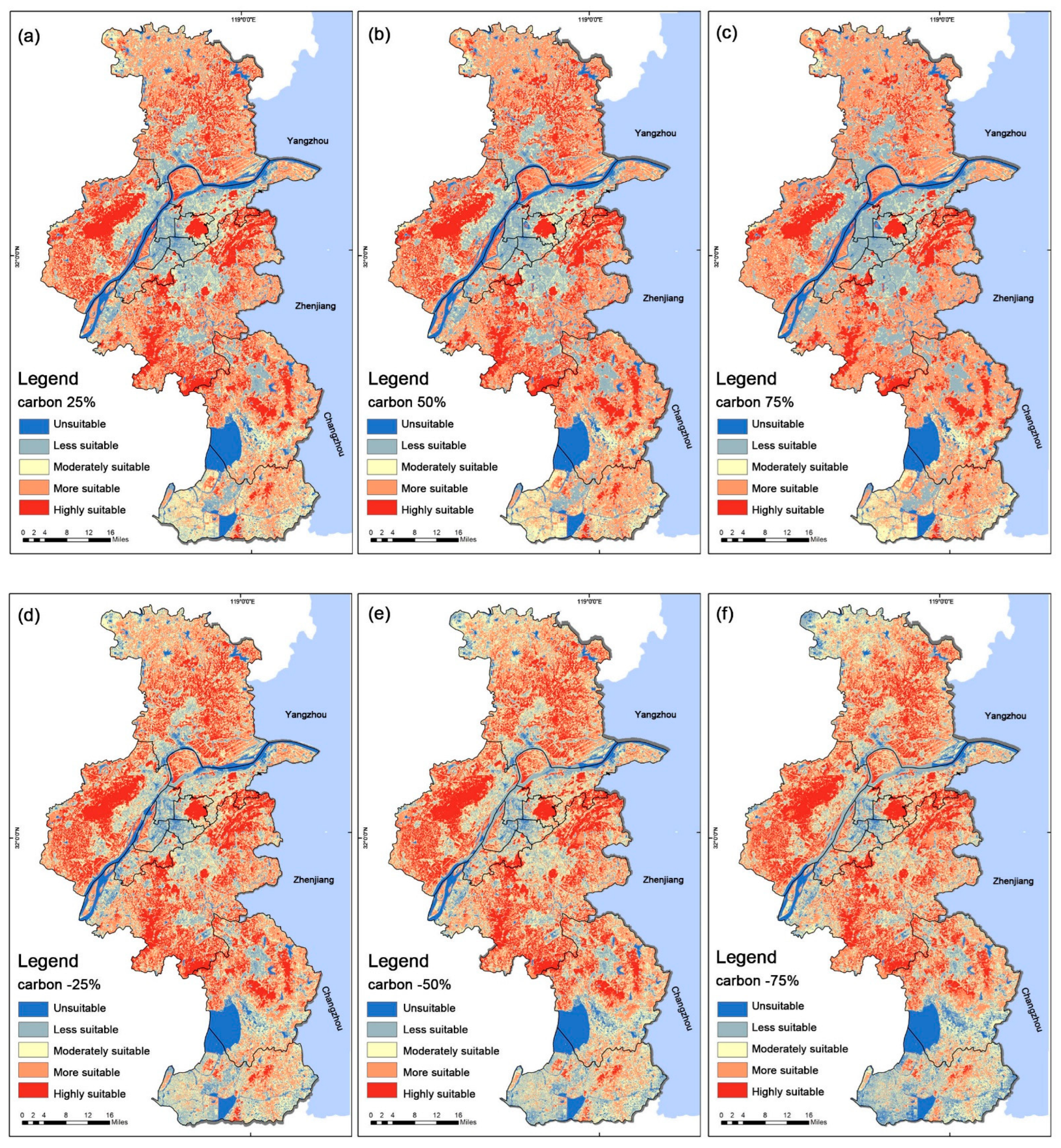
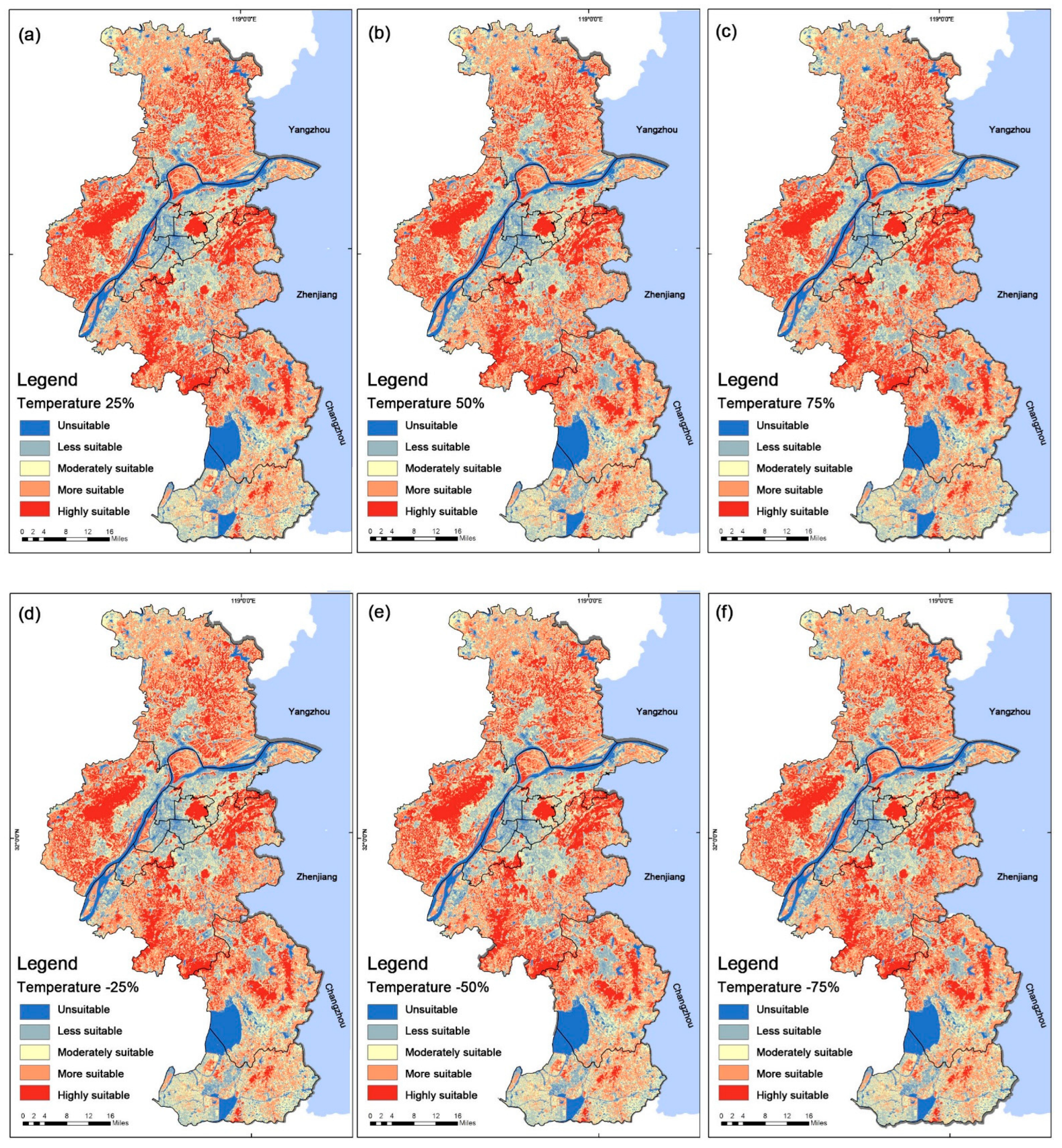
| Main Criteria | Sub-Criteria | Upper-Limit | Lower-Limit | Function Type | References |
|---|---|---|---|---|---|
| Physical | Elevation | 448.0 | −122 | Linear (decreasing) | Ustaoglu and Aydinoglu (2020); Luan et al. (2021) [48,86] |
| Slope | 64.0 | 0 | Linear (decreasing) | Ustaoglu and Aydinoglu (2020); Luan et al. (2021) [48,86] | |
| Aspect | 225 | 10 | Gaussian | Rahimi et al. (2020) [103] | |
| Natural | Precipitation | 1570.1 | 1271.1 | Linear (decreasing) | Pussel and Li (2019); Ronizi et al. (2020); Zabihi et al. (2020) [40,104,105] |
| Temperature | 17.30 | 15.24 | Linear (increasing) | Pussel and Li (2019); Mokarram et al. (2020); Zabihi et al. (2020) [40,104,105] | |
| Environmental | NDVI | 1 | 0 | Linear (increasing) | Pussel and Li (2019); Pakfetrat et al. (2020); Smith et al. (2021) [30,105,106] |
| Heat-island effect | 49.9 | 14.2 | Linear (decreasing) | Zhang et al. (2019); Smith et al. (2021) [35,106] | |
| Air pollution | 36.2 | 24.4 | Linear (decreasing) | Neema and Ohgai (2010); Pussel and Li (2019); Zhang et al. (2019) [31,35,105] | |
| Carbon storage | 25.9 | 0.1 | Linear (increasing) | Gratani et al. (2016); Shadman et al. (2022) [107,108] | |
| Accessible | Distance to metro stations | 36,430 | 0 | Linear (decreasing) | Zhang et al. (2013); Pussel and Li (2019) [85,105] |
| Distance to bus stops | 13,810.9 | 0 | Linear (decreasing) | Pussel and Li (2019) [105] | |
| Distance to major roads | 6340.2 | 0 | Linear (decreasing) | Zhang et al. (2013); Wang and Zhang (2014) [85,109] | |
| Human activities | Distance to densely populated areas | 240.1 | 0 | Linear (decreasing) | Neema and Ohgai (2010); Zhang et al. (2013); Zhang et al. (2019); Rahimi et al. (2020); Smith et al. (2021) [31,35,85,103,106] |
| Linguistic Scale of Importance | Fuzzy Number | Triangular Fuzzy Scale | Reciprocal Fuzzy Scale |
|---|---|---|---|
| Equally important | 1 | (1, 1, 1) | (1, 1, 1) |
| Moderately important | 3 | (2, 3, 4) | (1/4, 1/3, 1/2) |
| Strongly important | 5 | (4, 5, 6) | (1/6, 1/5, 1/4) |
| Very strongly important | 7 | (6, 7, 8) | (1/8, 1/7, 1/6) |
| Absolutely more important | 9 | (9, 9, 9) | (1/9, 1/9, 1/9) |
| Intermediate value | 2 | (1, 2, 3) | (1/3, 1/2, 1) |
| 4 | (3, 4, 5) | (1/5, 1/4, 1/3) | |
| 6 | (5, 6, 7) | (1/7, 1/6, 1/5) | |
| 8 | (7, 8, 9) | (1/9, 1/8, 1/7) |
| Layers | Elevation | Slope | Aspect | Precipitation | Temperature | NDVI | Heat-Island Effect | Pollution | Carbon | Metro Stations | Bus Station | Road | Population |
|---|---|---|---|---|---|---|---|---|---|---|---|---|---|
| Elevation | (1,1,1) | (1,1,2) | (1,2,2) | (1,3,4) | (1,3,4) | (0.14,0.17,0.2) | (0.17,0.2,0.25) | (0.17,0.2,0.25) | (0.13,0.14,0.14) | (0.25,0.33,0.5) | (0.25,0.33,0.5) | (0.2,0.33,0.33) | (0.2,0.25,0.33) |
| Slope | (0.5,1,1) | (1,1,1) | (1,2,2) | (2,3,3) | (2,3,3) | (0.14,0.17,0.2) | (0.17,0.2,0.25) | (0.17,0.2,0.25) | (0.13,0.14,0.17) | (0.25,0.33,0.5) | (0.25,0.33,0.5) | (0.25,0.33,0.33) | (0.2,0.25,0.33) |
| Aspect | (0.5,0.5,1) | (0.5,0.5,1) | (1,1,1) | (1,2,2) | (1,2,2) | (0.13,0.14,0.17) | (0.14,0.17,0.2) | (0.14,0.17,0.2) | (0.11,0.13,0.14) | (0.2,0.25,0.33) | (0.2,0.25,0.33) | (0.17,0.25,0.33) | (0.17,0.2,0.25) |
| Precipitation | (0.25,0.33,1) | (0.33,0.33,0.5) | (0.5,0.5,1) | (1,1,1) | (0.5,1,1) | (0.11,0.13,0.14) | (0.13,0.14,0.17) | (0.13,0.14,0.17) | (0.11,0.11,0.13) | (0.17,0.2,0.25) | (0.17,0.2,0.25) | (0.17,0.2,0.2) | (0.14,0.17,0.2) |
| Temperature | (0.25,0.33,1) | (0.33,0.33,0.5) | (0.5,0.5,1) | (1,1,2) | (1,1,1) | (0.11,0.13,0.14) | (0.13,0.14,0.17) | (0.13,0.14,0.17) | (0.11,0.11,0.13) | (0.17,0.2,0.25) | (0.17,0.2,0.25) | (0.17,0.2,0.2) | (0.14,0.17,0.2) |
| NDVI | (5,6,7) | (5,6,7) | (6,7,8) | (7,8,9) | (7,8,9) | (1,1,1) | (1,2,3) | (1,2,4) | (0.33,0.5,1) | (3,4,5) | (3,4,5) | (3,4,4) | (1,3,4) |
| Heat-Island Effect | (4,5,6) | (4,5,6) | (5,6,7) | (6,7,8) | (6,7,8) | (0.33,0.5,1) | (1,1,1) | (1,1,2) | (0.25,0.33,0.5) | (1,3,4) | (1,3,4) | (2,3,3) | (1,2,2) |
| Pollution | (4,5,6) | (4,5,6) | (5,6,7) | (6,7,8) | (6,7,8) | (0.25,0.5,1) | (0.5,1,1) | (1,1,1) | (0.33,0.33,0.5) | (1,3,3) | (1,3,3) | (2,3,3) | (1,2,3) |
| Carbon | (7,7,8) | (6,7,8) | (7,8,9) | (8,9,9) | (8,9,9) | (1,2,3) | (2,3,4) | (2,3,3) | (1,1,1) | (4,5,6) | (4,5,6) | (4,5,5) | (3,4,5) |
| Metro Station | (2,3,4) | (2,3,4) | (3,4,5) | (4,5,6) | (4,5,6) | (0.2,0.25,0.33) | (0.25,0.33,1) | (0.33,0.33,1) | (0.17,0.2,0.25) | (1,1,1) | (1,1,2) | (0.5,1,1) | (0.33,0.5,1) |
| Bus Station | (2,3,4) | (2,3,4) | (3,4,5) | (4,5,6) | (4,5,6) | (0.2,0.25,0.33) | (0.25,0.33,1) | (0.33,0.33,1) | (0.17,0.2,0.25) | (0.5,1,1) | (1,1,1) | (0.5,1,1) | (0.33,0.5,1) |
| Road | (3,3,5) | (3,3,4) | (3,4,6) | (5,5,6) | (5,5,6) | (0.25,0.25,0.33) | (0.33,0.33,0.5) | (0.33,0.33,0.5) | (0.2,0.2,0.25) | (1,1,2) | (1,1,2) | (1,1,1) | (0.33,0.5,1) |
| Population | (3,4,5) | (3,4,5) | (4,5,6) | (5,6,7) | (5,6,7) | (0.25,0.33,1) | (0.5,0.5,1) | (0.33,0.5,1) | (0.2,0.25,0.33) | (1,2,3) | (1,2,3) | (1,2,3) | (1,1,1) |
| Weight | 0.038825 | 0.036223 | 0.023650 | 0.014442 | 0.014364 | 0.148227 | 0.120379 | 0.120349 | 0.176840 | 0.071047 | 0.071124 | 0.070274 | 0.094254 |
| Rank | 9 | 10 | 11 | 12 | 13 | 2 | 3 | 4 | 1 | 7 | 6 | 8 | 5 |
| Consistency Check | λmax = 13.544; CI = 0.045; CR = 0.029; Consistency check passed. | ||||||||||||
| District | Classes of the Urban Parks | Existing Urban Parks | |||||
|---|---|---|---|---|---|---|---|
| S1 | S2 | S3 | S4 | S5 | Area | Difference | |
| Jianye | 20 km2 | 26 km2 | 12 km2 | 13 km2 | 7 km2 | 2 km2 | 6 km2 |
| Lishui | 135 km2 | 169 km2 | 238 km2 | 334 km2 | 182 km2 | 27 km2 | 155 km2 |
| Qinhuai | 6 km2 | 30 km2 | 11 km2 | 2 km2 | 0 km2 | 1 km2 | 0 km2 |
| Xuanwu | 1 km2 | 21 km2 | 18 km2 | 8 km2 | 28 km2 | 30 km2 | −2 km2 |
| Qixia | 56 km2 | 97 km2 | 103 km2 | 80 km2 | 54 km2 | 33 km2 | 21 km2 |
| Gulou | 8 km2 | 34 km2 | 9 km2 | 1 km2 | 2 km2 | 6 km2 | −4 km2 |
| Gaochun | 97 km2 | 180 km2 | 273 km2 | 209 km2 | 34 km2 | 3 km2 | 32 km2 |
| Yuhua | 11 km2 | 47 km2 | 33 km2 | 17 km2 | 24 km2 | 11 km2 | 13 km2 |
| Jiangning | 71 km2 | 261 km2 | 335 km2 | 444 km2 | 451 km2 | 20 km2 | 431 km2 |
| Pukou | 48 km2 | 135 km2 | 184 km2 | 222 km2 | 319 km2 | 49 km2 | 270 km2 |
| Liuhe | 77 km2 | 224 km2 | 361 km2 | 514 km2 | 299 km2 | 3 km2 | 296 km2 |
| Total | 531 km2 (8%) | 1223 km2 (19%) | 1578 km2 (24%) | 1844 km2 (28%) | 1401 km2 (21%) | 183 km2 | 1217 km2 |
| Change (%) | Weight Value (Carbon Storage) | ||||||||||||
|---|---|---|---|---|---|---|---|---|---|---|---|---|---|
| Elevation | Slope | Aspect | Precipitation | Temperature | NDVI | Heat-Island Effect | Pollution | Carbon | Metro Stations | Bus Station | Road | Population | |
| 75 | 0.0326 | 0.0304 | 0.0198 | 0.0121 | 0.0120 | 0.1243 | 0.1010 | 0.1010 | 0.3095 | 0.0596 | 0.0597 | 0.0590 | 0.0791 |
| 50 | 0.0347 | 0.0323 | 0.0211 | 0.0129 | 0.0128 | 0.1323 | 0.1074 | 0.1074 | 0.2653 | 0.0634 | 0.0635 | 0.0627 | 0.0841 |
| 25 | 0.0367 | 0.0343 | 0.0224 | 0.0137 | 0.0136 | 0.1403 | 0.1139 | 0.1139 | 0.2211 | 0.0672 | 0.0673 | 0.0665 | 0.0892 |
| 0 | 0.0388 | 0.0362 | 0.0237 | 0.0144 | 0.0144 | 0.1482 | 0.1204 | 0.1203 | 0.1768 | 0.0710 | 0.0711 | 0.0703 | 0.0943 |
| −25 | 0.0409 | 0.0382 | 0.0249 | 0.0152 | 0.0151 | 0.1562 | 0.1268 | 0.1268 | 0.1326 | 0.0749 | 0.0749 | 0.0740 | 0.0993 |
| −50 | 0.0430 | 0.0401 | 0.0262 | 0.0160 | 0.0159 | 0.1641 | 0.1333 | 0.1333 | 0.0884 | 0.0787 | 0.0788 | 0.0778 | 0.1044 |
| −75 | 0.0451 | 0.0421 | 0.0275 | 0.0168 | 0.0167 | 0.1721 | 0.1398 | 0.1397 | 0.0442 | 0.0825 | 0.0826 | 0.0816 | 0.1094 |
| Change (%) | Weight Value (Temperature) | ||||||||||||
| Elevation | Slope | Aspect | Precipitation | Temperature | NDVI | Heat-Island Effect | Pollution | Carbon | Metro Stations | Bus Station | Road | Population | |
| 75 | 0.0384 | 0.0358 | 0.0234 | 0.0143 | 0.0251 | 0.1466 | 0.1191 | 0.1190 | 0.1749 | 0.0703 | 0.0703 | 0.0695 | 0.0932 |
| 50 | 0.0385 | 0.0360 | 0.0235 | 0.0143 | 0.0215 | 0.1471 | 0.1195 | 0.1195 | 0.1756 | 0.0705 | 0.0706 | 0.0698 | 0.0936 |
| 25 | 0.0387 | 0.0361 | 0.0236 | 0.0144 | 0.0180 | 0.1477 | 0.1199 | 0.1199 | 0.1762 | 0.0708 | 0.0709 | 0.0700 | 0.0939 |
| 0 | 0.0388 | 0.0362 | 0.0237 | 0.0144 | 0.0144 | 0.1482 | 0.1204 | 0.1203 | 0.1768 | 0.0710 | 0.0711 | 0.0703 | 0.0943 |
| −25 | 0.0390 | 0.0364 | 0.0237 | 0.0145 | 0.0108 | 0.1488 | 0.1208 | 0.1208 | 0.1775 | 0.0713 | 0.0714 | 0.0705 | 0.0946 |
| −50 | 0.0391 | 0.0365 | 0.0238 | 0.0145 | 0.0072 | 0.1493 | 0.1213 | 0.1212 | 0.1781 | 0.0716 | 0.0716 | 0.0708 | 0.0949 |
| −75 | 0.0392 | 0.0366 | 0.0239 | 0.0146 | 0.0036 | 0.1498 | 0.1217 | 0.1217 | 0.1788 | 0.0718 | 0.0719 | 0.0710 | 0.0953 |
| Change (%) | Suitability (km2) | Change in Suitability(%) | ||||||||
|---|---|---|---|---|---|---|---|---|---|---|
| S1 | S2 | S3 | S4 | S5 | S1 | S2 | S3 | S4 | S5 | |
| Carbon storage | ||||||||||
| 75 | 517.58 | 1464.48 | 1062.57 | 2570.81 | 960.67 | −2.53% | 19.74% | −32.66% | 39.44% | −31.41% |
| 50 | 511.41 | 1301.14 | 1238.25 | 2213.31 | 1312.00 | −3.69% | 6.38% | −21.52% | 20.05% | −6.32% |
| 25 | 520.00 | 1285.00 | 1426.00 | 2013.00 | 1331.00 | −2.07% | 5.06% | −9.62% | 8.41% | −4.97% |
| 0 | 531.02 | 1223.07 | 1577.81 | 1843.64 | 1400.58 | 0.00% | 0.00% | 0.00% | 0.00% | 0.00% |
| −25 | 498.44 | 1193.38 | 1628.87 | 1871.49 | 1383.93 | −6.13% | −2.43% | 3.24% | 1.51% | −1.19% |
| −50 | 449.61 | 1172.32 | 1711.49 | 1864.83 | 1377.85 | −15.33% | −4.15% | 8.47% | 1.15% | −1.62% |
| −75 | 499.34 | 1242.59 | 1720.72 | 1828.80 | 1284.66 | −5.96% | 1.60% | 9.06% | −0.80% | −8.28% |
| Temperature | ||||||||||
| 75 | 547.46 | 1210.51 | 1587.90 | 1858.94 | 1371.30 | 3.10% | −1.03% | 0.64% | 0.83% | −2.09% |
| 50 | 536.13 | 1235.71 | 1589.14 | 1857.65 | 1357.49 | 0.96% | 1.03% | 0.72% | 0.76% | −3.08% |
| 25 | 542.36 | 1197.86 | 1576.75 | 1845.02 | 1414.13 | 2.14% | −2.06% | −0.07% | 0.07% | 0.97% |
| 0 | 531.02 | 1223.07 | 1577.81 | 1843.64 | 1400.58 | 0.00% | 0.00% | 0.00% | 0.00% | 0.00% |
| −25 | 537.02 | 1231.01 | 1578.77 | 1842.15 | 1387.16 | 1.13% | 0.65% | 0.06% | −0.08% | −0.96% |
| −50 | 525.49 | 1210.94 | 1566.72 | 1899.15 | 1373.82 | −1.04% | −0.99% | −0.70% | 3.01% | −1.95% |
| −75 | 531.74 | 1218.28 | 1567.58 | 1897.93 | 1360.58 | 0.14% | −0.39% | −0.65% | 2.94% | −2.86% |
Publisher’s Note: MDPI stays neutral with regard to jurisdictional claims in published maps and institutional affiliations. |
© 2022 by the authors. Licensee MDPI, Basel, Switzerland. This article is an open access article distributed under the terms and conditions of the Creative Commons Attribution (CC BY) license (https://creativecommons.org/licenses/by/4.0/).
Share and Cite
Li, C.; Zhang, T.; Wang, X.; Lian, Z. Site Selection of Urban Parks Based on Fuzzy-Analytic Hierarchy Process (F-AHP): A Case Study of Nanjing, China. Int. J. Environ. Res. Public Health 2022, 19, 13159. https://doi.org/10.3390/ijerph192013159
Li C, Zhang T, Wang X, Lian Z. Site Selection of Urban Parks Based on Fuzzy-Analytic Hierarchy Process (F-AHP): A Case Study of Nanjing, China. International Journal of Environmental Research and Public Health. 2022; 19(20):13159. https://doi.org/10.3390/ijerph192013159
Chicago/Turabian StyleLi, Chenying, Tiantian Zhang, Xi Wang, and Zefeng Lian. 2022. "Site Selection of Urban Parks Based on Fuzzy-Analytic Hierarchy Process (F-AHP): A Case Study of Nanjing, China" International Journal of Environmental Research and Public Health 19, no. 20: 13159. https://doi.org/10.3390/ijerph192013159






